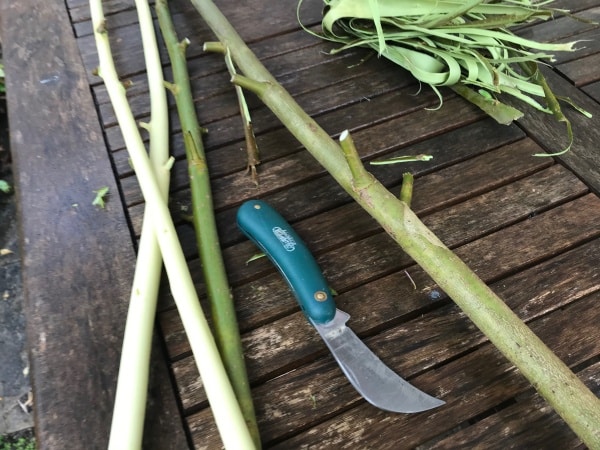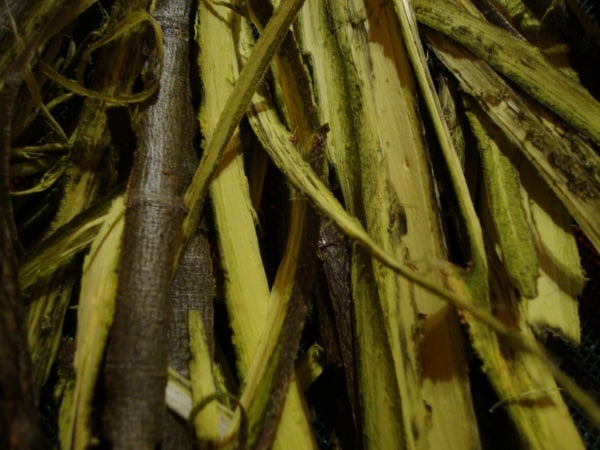From capsules to tinctures, the herbal actions of medicinal tree barks can be relevant in many complaints from simple constipation to chronic arthritis, from menstrual cramps to combatting infection. Bark is a wonderful source for herbal remedies as it can be taken from coppiced or pollarded branches, so it is potentially a sustainable source – it does not need to be stripped from a main trunk which could kill a tree. Of course a reminder is needed that while herbal medicines may be highly suitable for common complaints (such as colds, coughs, digestive problems and many more) it is very important to take advice from a qualified herbal or medical practitioner if you are on prescription medication or presenting with red flag or worsening symptoms.
Antiseptic pine bark for colds
Pine trees (Pinus species) offer a fantastic source of antiseptic and anti-inflammatory activity. Usually people think of the resinous essential oils derived from distillation of pine bark or leaves, or even tapping resin from a damaged trunk. Pine bark has a considerable market as a herbal supplement high in polyphenols for anti-inflammatory purposes such as Pycnogenol from French pine (Pinus pinaster) sold for arthritis. The bark and the needles can be used as an infusion in hot water to provide steam inhalation in colds and coughs. Pine is also a source of vitamin C. For self-help purposes pine bark can be broken up and stewed in water and the liquid drunk. There are many species of pine so it is possible to find one to suit most cultivation conditions – sometimes wind will bring down branches which can then be harvested for needles and bark. Conifers are not usually coppiced successfully though stump cutting may be practiced in USA.
Antitussive cherry bark for dry coughs
Cherry bark of most species can be used though generally wild cherry (Prunus avium) or bird cherry (Prunus padus) are found in UK. In USA the black cherry (Prunus serotina) is more likely to be used. The bark of a cherry tree is readily recognized by its shiny brown-purple coloring with horizontal bands. Cherry trees are strong growers that can be readily pollarded or coppiced, providing young branches a few years old suitable for the harvest of bark. The cherry bark contains cyanoglycosides which are effective in low doses to reduce spasmodic coughing. The kind of cough best helped is a dry cough that is not productive. The bark extract can be made into cough syrup.
Antispasmodic cramp bark for period pains
Cramp bark is also known as the guelder rose (Viburnum opulus) and is a small tree with large panicles of white flowers and intensely bitter red fruits. The constituents of the bark provide a strongly antispasmodic effect which is very useful for symptomatic help for colicky or cramplike pains. The dried powdered bark can be taken in capsules made with a simple capsule filling machine. Alternatively a syrup or tincture can be made from the bark.







Alder buckthorn bark for constipation
Perhaps some less well-known shrubs and trees are worth considering for their bark too, and the alder buckthorn (Frangula alnus) is an effective traditional laxative. Alder buckthorn is one of two native buckthorns in UK (the other is the purging buckthorn (Rhamnus cathartica)). In the USA the related cascara buckthorn (Rhamnus purshiana) provides a well-known laxative bark. The emodin content of these barks also gives antibacterial and anticancer effects. Emodin is a popular constituent in Chinese traditional medicine and it is also found in docks and rhubarbs. Traditionally these laxative barks are harvested and then stored for a year to reduce constituents that cause excessive griping. The bark can be soaked in water and then used to make a syrup. The remedy contains anthraquinones which break down in the gut producing peristalsis some 8 hours later. The effect is a stimulating laxative.
Anti-inflammatory willow for arthritic pain
Willow family members are rich in salicylates, this content can be identified in the bitter tasting bark. Darker willow stems often indicate the higher salicin content and this is broken down in the body to give salicylic acid, with anti-inflammatory effects. There are other constituents and it is likely the painkilling effects are due to a synergy of many components, The willow remedy is NOT the same as aspirin which is a single molecule artificially prepared and can have irreversible effects on the stomach lining if not taken with food. This gives aspirin its position as one of the most dangerous over-the-counter medications if a stomach bleed is caused. Fresh willow bark can be chewed, though intensely bitter, more likely to dry and powder bark for use in capsules or to make alcohol and water tincture.
Astringent witch hazel for acne and skin complaints
The bark of the Virginian witch hazel (Hamamelis virginiana) is distilled in North America for worldwide use in eye and skin care. This small tree is dragged out of oak forests and entirely chipped, and then distilled for up to three days. We have found it does well on acid soils in the UK and can be harvested for leafy twigs to be distilled in small batches for up to 2 hours. There is another pharmacopoeia standard for distilled witch hazel water which is based on the young leafy twigs and this is a more sustainable mode of production. The distilled water is anti-inflammatory and astringent and it has many body care uses from eye drops to first aid for insect bites and sprains. As a toning and drying lotion it can be useful in acne too.
Use bark as a sustainable resource
Tree bark offers a range of herbal actions, adaptogenic, anti-inflammatory, antimicrobial, antioxidant, antiseptic, antispasmodic, antiviral, astringent, laxative. And tree bark can be made into a range of preparations – capsules, decoction, distillation, infusion (tea), syrup, tincture. As a sustainable material from trees I hope to encourage you to use these amazing medicinal tree barks!

References
Here are a few of the many research references available – and ther is more detail in The Medicinal Forest Garden Handbook (2020) by Anne Stobart.
Piątczak E, Dybowska M, Płuciennik E, et al. (2020) Identification and accumulation of phenolic compounds in the leaves and bark of Salix alba (L.) and their biological potential. Biomolecules 10(10): 1391.
Robertson NU, Schoonees A, Brand A, et al. (2020) Pine bark (Pinus spp.) extract for treating chronic disorders. Cochrane Database Syst Rev 9: CD008294.
Telichowska A, Kobus-Cisowska J and Szulc P (2020) Phytopharmacological possibilities of bird cherry Prunus padus L. and Prunus serotina L. species and their bioactive phytochemicals. Nutrients 12(7): 1966.
